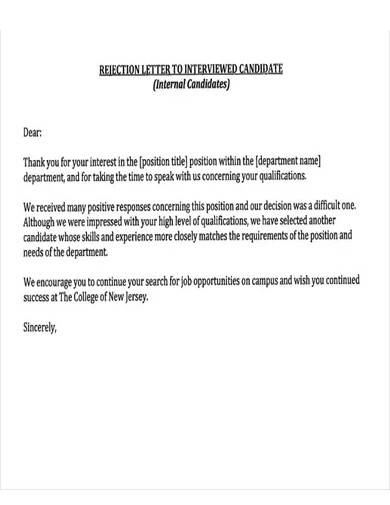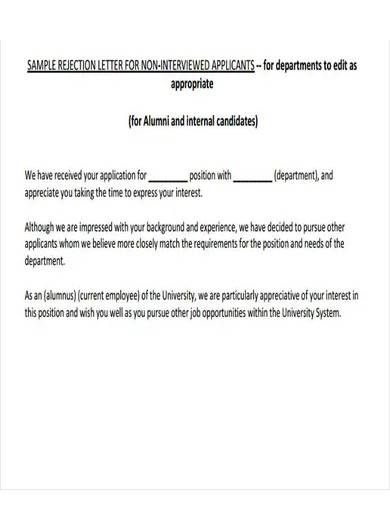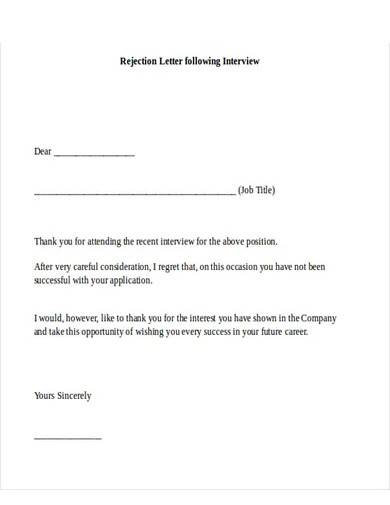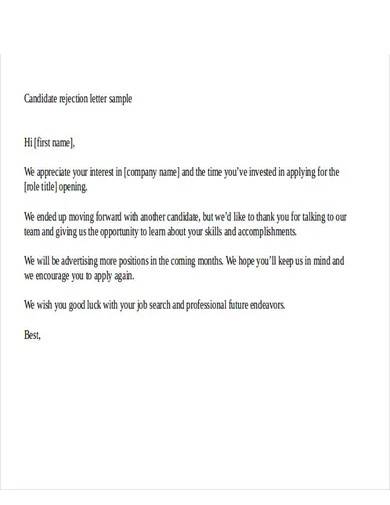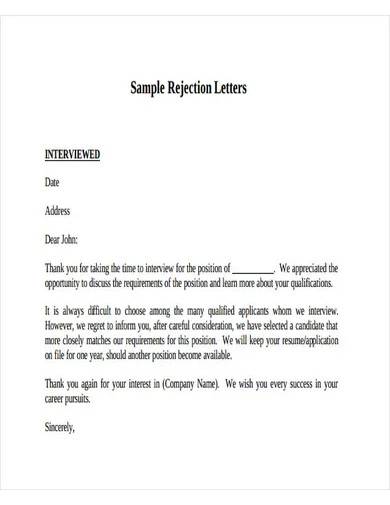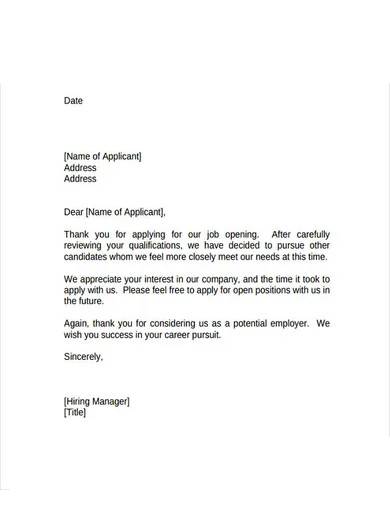Before Steven Speilberg became a household name for “Jaws,” his biggest break and one of cinema history’s highest-grossing films of all time, he was rejected three times from the University of South Carolina’s film school because of his low marks. He was underqualified for a film degree, and yet, he became a recipient of three Oscar awards. Indeed, rejection is never a dead end, but it helps to not stain anyone’s memory of dismissal from their desired opportunity. Have a well-written job applicant rejection letter to back you up. This helps you express an aspirant’s rejection the right way. Know more about this by scrolling down below.
FREE 8+ Job Applicant Rejection Letter Samples
1. Free Job Applicant Rejection Letter
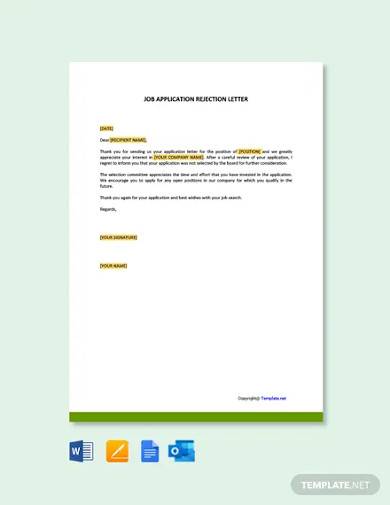
2. Free Professional Job Applicant Rejection Letter
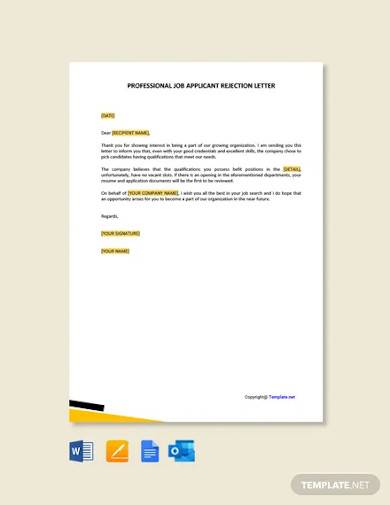
3. Free Internal Job Applicant Rejection Letter

4. Rejection Letter to Interviewed Candidate
5. Job Applicant Rejection Letter to Non-Interviewed
6. Rejection Letter to Following Interview
7. Sample Candidate Rejection Letter
8. Job Applicant Rejection Letter
9. Formal Job Applicant Rejection Letter
What Is a Job Applicant Rejection Letter?
A job applicant rejection letter is a letter that informs a job aspirant that he or she failed to advance to another round of the applications or fell short in getting the position.
Application Rejection: How to Do It Right
If you think only those who lack the right skills get rejected from job applications, you’re wrong. Everyone gets their fair share of chances and standards when it comes to getting hired into an opportunity. Apparently, even the most talented and admirable candidates get rejection memos as well. According to Forbes, there are various reasons why even qualified applicants experience being denied as well. This includes changes in the specifications, being overqualified, or the lack of relevant experiences.
As a company, even if you hope to have a rigid and objective recruitment plan, getting rejected is scarring. It’s an upsetting experience that can get even worse if you fail to handle it well. Here are some ways on how you reject a candidate the right way:
1. Inform the applicant about the rejection as soon as you hear the result. It’s not right to let an aspirant wait for a long time before breaking the unfortunate news. This allows your candidate to move forward to another company instead of waiting in vain.
2. Avoid discriminatory remarks. Never blurt out personal or judgmental reasons for rejection, or you might risk having a lawsuit filed against you. Keep it objective and base your observation on an individual’s professional background on the employment resume and interview performance.
3. Keep the news brief. If you wish to pick up the phone and inform the candidate that he failed, avoid lengthy conversations. Keep the message clear, brief, and direct.
4. Avoid false promises. In hopes of lifting an applicant’s spirits following the rejection, you might assure him another application opportunity when a slot becomes empty even when he’s unqualified. Never say anything that you don’t mean.
How to Write a Job Applicant Rejection Letter
To help you get started, here are some tips on how to write a job rejection letter well:
1. Be Grateful, Not Sorry
The very nature of sending an applicant rejection letter already has a negative connotation. Don’t add more salt to the wound by extending your regrets and sympathy to the candidate. Instead, be grateful. Avoid terms such as “regrettably,” “unfortunately,” “saddening,” or any somber vocabulary. Greet the applicants with a warm appreciation of their efforts and for lending a significant amount of their time to attend your hiring process. While you may express that you’re sorry for the unfavorable results, focus on expressing your gratitude for their effort. This should be on your letter’s introduction, along with direct news that they failed to get the position.
2. Give an Explanation
Most standard rejection letters or rejection emails won’t bother giving the reason behind their denial to grant an interview or employment to a candidate. However, these aspirants wouldn’t help themselves but think about what went wrong with their performance. They’ll ask why and they’ll never know. Instead of attacking the inconsistencies or the mistakes the candidate made during the application, refer to your objectives or to the qualifications that the person lacks. As an example, you may point that the position’s job description needs someone who’s highly-skilled in finance and management, and the person is still yet to achieve that. It’s easier for them to process the rejection response when they understand what the company needs.
3. Personalize with a Feedback
Feedbacks are rare when it comes to sending professional rejection letters. However, if you want to humanize the document and make a content that the candidate will truly appreciate, include personalized feedback. It’s not new to send the same letter script to multiple individuals but try to include your observations of the applicant’s strengths. Is he a good conversationalist? Does he lead engaging discussions? Does he have an impressive background? Refer to a person’s resume and performance and take note of positive remarks. This makes your employment rejection letter polite and meaningful.
4. Include an Invitation
If you’re among the recruiting agents who are organizing the hiring process, There are numerous chances where you’d come across potential talents but only have limited slots open. That’s a regrettable loss. Express your desire to invite an applicant again for another opportunity when it comes up. Make the candidates know that they’ve performed well, but the timing isn’t right. This way, you’d have a list of great potentials that can join your organization.
FAQ
Can you reject an applicant through a text message or email?
Yes, but this is only acceptable if the applicant did not undergo an interview. If they came to your office for an interview, it’s best to notify them of their rejection through a phone call.
Do you need to reply to a rejection letter?
No, it’s not necessary to respond to a rejection letter, but you can send your thanks.
If it’s not stated in the rejection letter, can you ask why you failed the application?
According to Forbes, it’s acceptable to call the company and ask why and how you failed the process to let you know how you could’ve done it better.
People who fail are not failures; they’re the ones who are brave enough to try. In most cases, getting rejected leads you to a much better opportunity than what you’ve always hoped for. However, if you’re an applicant who’s desperate for a position, it’s hard to see rejection from this perspective. As a recruiting team, all you can do is make their experience less painful than it should be. Take your pick from our rejection letter templates and send the unfortunate news in a lighter mood. Download now!
Related Posts
FREE 9+ Sample Formal Interview Letter Templates in MS Word PDF
FREE 5+ Sample Application Letters for Job in MS Word PDF
FREE 55+ Job Letter Templates in PDF MS Word
FREE 8+ Application Writing Samples in PDF MS Word
FREE 7+ Sample Job Appointment Letter Templates in MS Word PDF
FREE 7+ Sample Job Rejection Letter Templates in MS Word PDF
FREE 32+ Sample Interview Thank You Letter Templates in MS ...
FREE 30+ Application Letter Samples & Templates in PDF MS Word
FREE 8+ Sample Thank-You Letters for Job Interview in MS Word ...
FREE 6+ Sample Proposal Rejection Letter Templates in MS Word ...
FREE 101+ Sample Letter Templates in MS Word PDF
FREE 5+ Settlement Rejection Letter Samples in PDF DOC
FREE 11+ Employment Letter Samples in MS Word PDF
FREE 8+ Sample Letter of Employment in PDF MS Word
FREE 15+ Sample Appointment Letter Templates in PDF MS Word ...

